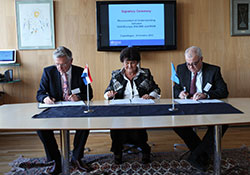Antibiotic resistance surveillance network extended throughout European Region

WHO
On 30 October, WHO/Europe signed an agreement with the National Institute for Public Health and the Environment (RIVM) of the Netherlands, and the European Society of Clinical Microbiology and Infectious Diseases (ESCMID) to expand surveillance of antimicrobial resistance to cover all countries in the WHO European Region.
The establishment of this new Central Asia and European Surveillance of Antimicrobial Resistance (CAESAR) network is a key component of the European action plan on antibiotic resistance, agreed by Member States in September 2011.
“This is very strong tripartite collaboration,” stated Zsuzsanna Jakab, WHO Regional Director for Europe, at the signing. “The agreement brings together the partners’ different surveillance capacities: ESCMID for its expertise in diagnostics, RIVM for its expertise in epidemiology and WHO for its country reach and convening powers.”
“We know we can work together, because we have done so for many years,” added Gunnar Kahlmeter, President of ESCMID.
CAESAR’s surveillance work will complement that of the European Centre for Disease Prevention and Control (ECDC) through the European Antimicrobial Resistance Surveillance Network (EARS-Net). To enable comparison of data for the whole European Region, CAESAR will use the EARS-Net methodology in close collaboration with ECDC.
Concluding the signing ceremony, Andre van der Zande, Director-General of RIVM, commented, “RIVM is proud that the efforts that went into developing what is now EARS-Net are also being used to develop CAESAR.”
The increase and spread of bacteria that are resistant to the antibiotics developed to kill them are a major threat to health in the WHO European Region. Mapping antibiotic use and resistance is vital, providing health professionals, risk managers and decision-makers with the evidence they need to prioritize their resources and efforts to contain antibiotic resistance.



